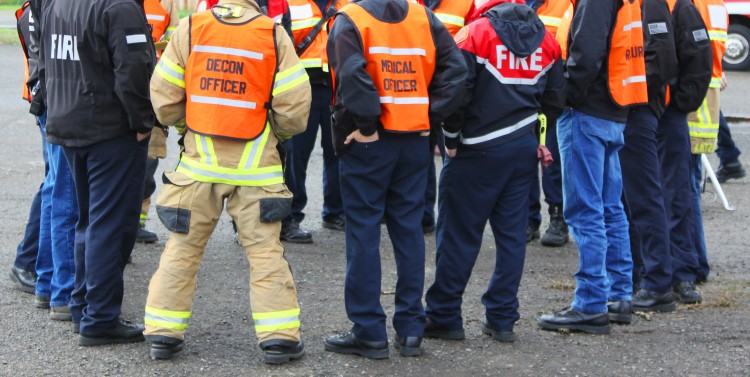When disaster strikes, a peaceful community can quickly turn chaotic. From earthquakes and landslides to chemical spills and acts of terrorism, disasters have far-reaching impacts on civilians, infrastructure and vital resources like safe drinking water — disrupting lives and threatening public safety.
Incident commanders are professionals tasked with preparing for and responding to emergencies. A business may hire an incident commander to oversee emergency preparedness or they may work for an organization that responds to large-scale disasters.
An incident commander is expected to have exceptional planning and assessment skills, honed through years of experience. An advanced education can also help individuals prepare for this important role.
Incident Commander Responsibilities
According to the Federal Emergency Management Agency (FEMA), the primary responsibility of an incident commander is to oversee incident management and supervise the staff assigned to it.
Specific responsibilities vary by situation. For example, how an incident commander responds to an oceanic chemical spill differs greatly from the response to an earthquake that’s caused significant property damage.
Regardless of the type of scenario, an incident commander’s responsibilities can generally be divided into the five areas below.
No. 1: Hazard Assessment
Disasters and other emergency scenarios can happen at any time, so much of what an incident commander does is assess potential hazards in anticipation of an event. Assessment typically involves:
- Analyzing data to determine which disasters are most likely to happen
- Identifying potential risks in the workplace
- Researching ways to mitigate the risk of a disaster
- Reviewing existing emergency response strategies and their outcomes
No. 2: Emergency Management Policy Development
Emergency management policies ensure that a clearly defined plan is in place for any given situation. For incident commanders, developing an effective emergency management plan typically entails the following:
- Creating emergency supply lists
- Ensuring that adequate funds are in reserve for emergencies
- Developing detailed instructions on how emergencies should be handled
- Creating maps of evacuation routes, shelter locations and locations of resources
- Writing or amending policies to enhance emergency preparedness
No. 3: Employee Training
Incident commanders are typically in charge of a team that carries out specific duties or assumes a certain role during a disaster. Examples include search and rescue teams, medical teams trained in delivering first aid, and specialist teams trained in mitigating the damage caused by chemicals and other harmful toxins.
Incident commanders must train employees and occasionally volunteers to ensure they’re prepared when emergencies occur. Doing so involves the following:
- Conducting safety training and disaster preparedness sessions
- Showing employees how to use safety equipment
- Reviewing policies and training materials
- Planning and conducting emergency drills
No. 4: Facility Preparation and Maintenance
In addition to preparing employees, incident commanders must also prepare facilities for potential emergencies. This may entail the following:
- Stocking the facility with first aid kits and emergency eye-washing stations
- Weatherproofing the facility to withstand hurricanes, tornadoes, torrential rain, etc.
- Ensuring that emergency equipment and supplies are in good working order
- Ensuring that the facility doesn’t have any structural, electrical or utility defects
No. 5: Emergency Response Management
In an emergency, the incident commander assumes a leadership role and typically takes charge of the situation. If they’ve done their duty, all resources are in place and team members are properly trained on how to respond. During the emergency, the incident commander will:
- Communicate with first responders, such as the police and fire department
- Oversee employees to ensure that they’re following the disaster response plan
- Manage the distribution of resources
- Ensure that injured individuals receive medical attention
- Delegate tasks to employees, such as food and water distribution
- Mitigate damage to wildlife and natural resources
Post-emergency, the incident commander will analyze the response to identify areas of improvement; this may lead to policy and planning amendments.
How to Become an Incident Commander
Incident commanders need to have comprehensive knowledge of emergency management and possess leadership skills to be effective in their role. Aspiring incident commanders can build the necessary foundation to qualify for the role by pursuing an undergraduate education related to public safety. Relevant majors include the following:
- Public safety
- Public health
- Risk management
- Public administration
- Environmental science
Employers hiring an incident commander may prefer a candidate with an advanced education in emergency management. Additionally, candidates will likely need to accrue some experience in an entry-level or midlevel role before becoming an incident commander. Common roles include the following:
- Emergency management specialist
- Emergency preparedness officer
- Safety analyst
- Disaster recovery specialist
Through a combination of experience and education, individuals can develop the necessary skill set to lead during a crisis.
Make a Difference When It Matters Most
In an emergency, the difference between success and failure often comes down to preparation, planning and steady leadership. Incident commanders strive to ensure that businesses and communities are ready to navigate their way through crises.
Those who aspire to become incident commanders are encouraged to invest in an advanced education, such as Virginia Commonwealth University’s Master of Arts in Homeland Security and Emergency Preparedness online program. With courses in Emergency Management and Private Sector Preparedness, the program is designed to prepare leaders who can step up when the unpredictable and unexpected occur.
Explore the program and learn how it can help you achieve your professional goals.
